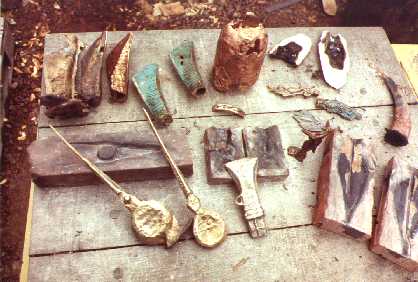
|
 |
The
Navan Centre (Eamhain Macha), Co. Armagh, August 1996
Niall O'Neill lifts a glowing crucible out of the furnace at the
start of the pour. What an adrenalin rush! |
 |
The
Ulster History Park, Omagh, July 1997
Major excavations for an experiment in melting bronze. The bronze
melted but it turned out we had the scale way off! The smaller the
pit, the more control you have over the melt (plus you can actually
get near it, haha!) |
 |
The
Ulster History Park, Omagh, July 1997
Some crucibles made for the Bronze Age pit experiment, preloaded
with copper & tin pellets. Also, to the right, several stone
moulds packed in sand for a pour. |
 |
The
Ulster History Park, Omagh, July 1997
An axe head clay mould, hot out of the oven and about to be filled
with molten bronze. This style of clay mould incorporating a complex
pour cup and core has proved very successful. |
 |
The
Ulster History Park, Omagh, July 17th - 31st, 1997
Completed bronze casts and stone moulds. At centre top is a bell
shape that was poured in a hand formed sand cast (with core!). At
right top is the remains (scorched white) of a cuttle fish mould,
a quick technique for small detailed pieces, a technique used mostly
by jewelers. Creating hollow cast objects, such as axe heads or
spear heads, proved to be the challenge of the week which we overcame
with a high degree of success considering the limited time frame. |
 |
The
Ulster Folk & Transport Museum , Co. Down
August 2nd - 13th 1999
Niall O'Neill puts on an impressive show during one of many evening
pours. Since we were staying in residence onsite, the group would
often work late into the evening to get as many castings in as possible. |
 |
The
Ulster Folk & Transport Museum , Co. Down
August 2nd - 13th 1999
Molten bronze being poured into a clay mould. This bronze was melted
in a small pit furnace, using a bellows and charcoal. For a sense
of scale, the tongs in the picture holding the crucible are just
standard kitchen tongs. The crucible was made by wrapping clay around
a prepared stick and sliding it off when it had dried sufficiently.
The crucible has a high sand content to help it withstand the heat,
as its melting point is not far above the bronze's melting point! |
|